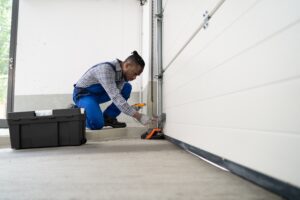Why Your Garage Door Won’t Close and What To Do

Opening your garage door to drive your car inside, only to have the door stop halfway and refuse to close is frustrating, to say the least. A garage door that won’t close all the way can happen for several reasons – some just require simple DIY fixes while others require professional help.
Knowing the common causes and solutions will help you get your garage door working again quickly and properly. Keep reading to understand why your garage door won’t close, signs to watch out for, and what to do based on the underlying problem.
4 Common Reasons a Garage Door Won’t Close
There are a few usual suspects when diagnosing why a garage door fails to close completely. Here are the most common culprits:
1. Photo Eyes Are Misaligned
The photo eyes are the sensors that tell your opener when it’s safe to close the door. When the eyes’ beams get knocked out of alignment, it triggers the safety stop in case something is obstructing the door.
It’s normal over time for vibration and bumps from opening and closing to slightly shift the photo eyes. A quick realignment is often all that’s needed to get things working again.
2. Broken Spring
The springs that counterbalance your garage door so it can open and close smoothly take an incredible beating each day. It’s not surprising they eventually wear out and break.
A broken spring prevents the opener from being able to lift the weight of the door. It will usually close part way before stopping due to the imbalance.

3. Bent Track
Garage door tracks guide the rollers as the door moves. However, they also take daily abuse from bumps of cars and other items. The constant pressure can deform parts of the track over time.
When the track gets bent out of shape, it forces the door to bind up rather than moving smoothly. The opener may then lack the power to close an imbalanced, sticking door.
4. Weak Opener
There is a lot of pressure on the electric opener to lift and lower the heavy door repeatedly. After years of use, the motor inevitably loses torque.
Once an old opener starts to fail, one of the first signs is the door stopping partway rather than fully closing (or opening). This usually means it’s time to replace the unit.
Warning Signs Your Garage Door Needs Attention
Don’t ignore that nagging feeling that your garage door doesn’t sound right or feels like it’s working harder than normal. Pay attention to these indicators so problems can be addressed before failure happens:
- Grinding, binding, or sticky movement
- Squeaking cables or rollers
- Lagging operation speed
- Uneven tracking or wobbling
- Difficult manual operation
- Loose or vibrating components
- Excessive wear on rollers/springs
Catching these garage door issues early gives you more repair options. Once components completely stop working properly, replacement is usually the only fix.
What To Do When Your Garage Door Stops Before Closing
Okay, your garage door refuses to fully close – now what? Follow this handy checklist to methodically diagnose and solve the problem:
Step 1: Test Door Balance
The first thing to check is if spring failure is causing an imbalance. Pull the emergency release handle to disconnect the door from the opener. Lift the door about halfway up then release gently.
A balanced door should stay suspended and not move. If it drifts down or crashes immediately, there’s an issue with spring tension. This will need to be addressed before any opener troubleshooting. Call a professional if a problem is found.
Step 2: Check Alignment
If the door passed the balance test, visually inspect the tracks and rollers inside your garage. Use a level to check for any sections that are bent or deformed. The tracks should be perfectly straight and secure.
Give the door a manual open/close cycle. It should glide smoothly with no sticky spots or excess wobble. If any alignment problems are spotted, loosen brackets and gently tap tracks back into proper shape.
Step 3: Realign Sensors
The photo eye sensors have alignment lights that make aiming easy. Usually just one set gets bumped – inspect them to see if an indicator is missing or looks dim/flickering.
Carefully adjust the crooked eye until it emits a solid beam again. Test for proper function by waving an object in their path then trying to close the door using the remote or wall button. If the safety reverse works, they might only need a minor realignment.
Step 4: Lube Up
A dry track and rollers contributes to resistance and binding issues. Clean the entire track rails with a rag then apply garage door lubricant. Grease all hinges/pivot points plus bearings inside steel rollers or nylon wheels.
This greatly reduces friction and heat buildup from metal-on-metal contact. Lubrication helps an aging opener move the door properly by freeing up sticky areas.

Step 5: Check Opener Motor
When all other systems check out fine yet the opener still fails to fully close the door, diminished motor power is likely the root cause.
Signs like slow speed, high pitch whining, humming without movement, or only partially opening/closing indicate worn brushes, depleted magnets, or excessive heat buildup.
Unfortunately once an opener motor starts to burn out, replacement is the only long-term solution. Budget-friendly direct drive models start around $150 for basic 1/2 hp versions. Higher torque 3/4 hp chain/belt drive openers provide better performance and durability for $200-450.
Installation cost depends on garage construction but averages $150-300. This garage upgrade pays for itself quickly in reliability and energy savings compared to constantly repairing an obsolete old model.
Step 6: When To Call A Pro
While many garage door issues can be DIY fixes, it’s smart to call a professional when:
- The door is significantly imbalanced, indicating broken springs
- Lifting the door manually is difficult
- Track alignment needs more than minor tweaks
- Greasing tracks/hardware doesn’t help
- Significant repairs are outside your skill level
Replacing torsion springs has risk of serious injury if tension bars are improperly secured. Let a qualified technician handle this hazardous task using the right tools. They can also determine if the door balance needs adjusting due to stretched cables.
Technicians have structural repair expertise from equipment like roller reformers to realign bent track sections. They’ll ensure rusty rollers get swapped out and security cables get replaced – not DIY friendly jobs.
Lastly, pros can diagnose motor and opener problems then recommend cost-effective solutions ranging from repairs, upgrades, or full replacements.
Don’t let a stuck garage door be a headache and inconvenience. Understanding common problems and smart step-by-step troubleshooting gets your door working again so you can park inside and secure your home. Recognizing when professional service is the smartest and safest choice ensures long-term reliable operation.

Anna has over six years of experience in the home services and journalism industries and serves as the Content Manager at MyHomePros.com, specializing in making complex home improvement topics like HVAC, roofing, and plumbing accessible to all. With a bachelor’s degree in journalism from Auburn University, she excels in crafting localized, comprehensive guides that cater to homeowners’ unique needs. Living on both coasts of the United States has equipped her with a distinctive perspective, fueling her passion for turning any house into a cherished home through informed, personalized decision-making.
